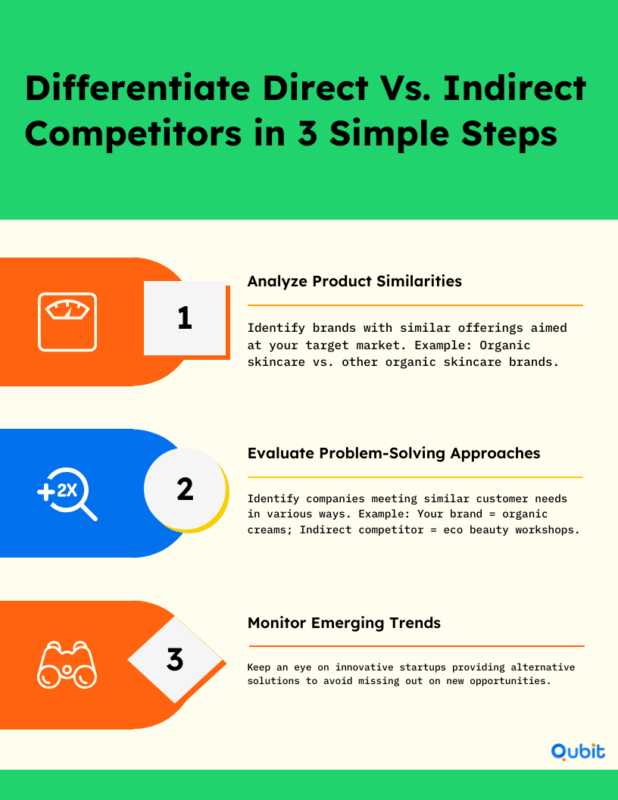Competition is an inevitable part of the startup journey, and understanding your competitors is crucial to thriving in the market. Whether you're launching a new product or entering an established industry, knowing who your competitors are—and what makes them tick—can shape your strategy and help you stand out. Knowing how to find investors for startups will also help you understand who your competitors are in the market
This blog will explore how startups can identify both direct and indirect competitors using actionable strategies and research tools. Let’s dive in and uncover the key steps to pinpointing your biggest rivals in the market!
Strategy to Identify Your Competitors
Understanding how to find a company's competitors is essential for refining your market strategy. Competitors can be classified into two types: direct and indirect. Direct competitors offer products or services that are similar to yours, targeting the same audience. Indirect competitors, on the other hand, address similar customer needs but through alternative solutions or approaches.
Steps to Differentiate Competitor Types

- Analyze Product Similarities
Start by identifying companies that provide products or services closely resembling yours. These are your direct competitors. For example, if you sell organic skincare products, other brands offering similar items in the same category are direct rivals. - Evaluate Problem-Solving Approaches
Look for businesses that solve the same customer problems differently. These are your indirect competitors. For instance, while your organic skincare brand targets eco-conscious consumers, an indirect competitor might offer sustainable beauty workshops or eco-friendly makeup alternatives. - Monitor Emerging Trends
Keep an eye on indirect competitors disrupting your market. According to a recent Competitor Trend, many startups fail to recognize how indirect rivals can impact their core offerings. This oversight can lead to missed opportunities for differentiation. - Use Strategic Content Marketing
To stand out, focus on creating compelling content that highlights your unique value. - Integrate Social Media with Multi-Channel Digital Outreach
Elevate your online presence by combining targeted social media strategies with broader digital marketing efforts such as search engine optimization, email campaigns, and strategic partnerships. This integrated approach not only amplifies your brand's reach across multiple platforms but also ensures that you engage customers where they are most active, fostering sustainable growth and brand loyalty.
By categorizing competitors effectively, you can tailor your strategies to outperform both direct and indirect rivals.
Strategies to Outperform Your Competitors
Success in competitive markets often hinges on measurable improvements in speed, pricing, and innovation. Businesses that prioritize being faster, more affordable, or more convenient can carve out a distinct advantage. For instance, Apple Metrics highlight how the brand markets its devices as superior choices, showcasing performance upgrades like 2x faster speed and 30% longer battery life.
Quantifiable enhancements such as price adjustments, streamlined processes, and increased product volume can make a significant impact. Sara Blakely’s story serves as a powerful example of how innovative branding can redefine an industry. Her approach to Spanx revolutionized shapewear, proving that highlighting superior product benefits can lead to market leadership.
Disruptive trends, like ride-sharing apps, demonstrate how embracing new technologies can challenge traditional business models. Another way to standout is by creating a startup unique value proposition. It should disrupt the industry, the way none of your competitors have been able to do.
Differentiating Your Startup from the Competition
Standing out among the competitors in the market requires more than just a great product or service. To truly differentiate your startup conduct a thorough competitive analysis for startups. Focus on qualitative aspects like cultivating a distinct brand voice and tone. These elements create a personality for your business that resonates with your audience, making your startup memorable and relatable.
A unique design philosophy also plays a pivotal role in setting your company apart. Whether it’s a visually striking logo, an intuitive user experience, or cohesive branding across platforms, design communicates your values and professionalism. Beyond aesthetics, consider the legacy you aim to build. What story will your startup tell in the years to come? A clear vision for your long-term impact not only inspires your team but also builds trust with customers.
By emphasizing these qualitative factors—branding, design, and legacy—you can carve out a distinct identity in even the most competitive industries. This approach ensures your startup isn’t just another name in the market but a brand that customers recognize and trust.
Map Your Competition with Visual Tools
Understanding your competitors' positioning can unlock hidden opportunities in your market. Visualization tools for monitoring competitors like perceptual maps are powerful for this purpose, offering a clear snapshot of where brands stand relative to one another. These tools allow businesses to assess market gaps and identify areas where new entrants can thrive.
By mapping competitors against key differentiators—such as price, quality, or innovation—you can uncover unoccupied segments that represent untapped potential. For instance, using a Value Map can highlight how placing your startup on a perceptual map reveals unoccupied market space. This approach not only clarifies your competitive landscape but also helps refine your strategy to target underserved customer needs.
Visualization tools simplify complex data, making it easier to spot trends and opportunities. Whether you're launching a new product or repositioning an existing one, these insights can guide you toward more informed decisions.
Integrating Market Intelligence into Content Strategy
Understanding your market is the cornerstone of a strong content strategy. By combining market research with competitive analysis, startups can uncover unique business strengths that set them apart. Market research provides insights into customer needs, preferences, and behaviors, while competitive analysis highlights gaps and opportunities within your industry. Together, these tools help craft content that resonates with your audience and positions your brand effectively.
For instance, identifying trends from market data can inspire blog topics or social media campaigns that directly address customer pain points. Similarly, analyzing competitors’ strategies can reveal areas where your startup excels, allowing you to emphasize those differentiators in your messaging.
A well-informed content strategy not only enhances your market positioning but also builds trust with your audience by showcasing your expertise and understanding of their needs.
Harnessing Market Research to Identify Your Audience
Understanding your audience begins with effective market research. By combining insights into consumer behavior with economic trends, businesses can gauge demand and validate their ideas. Market research strategies like surveys and focus groups offer practical ways to assess preferences, while tools such as employment statistics help analyze workforce demographics to confirm demand viability.
Assessing Market Size is equally critical. This figure, which estimates potential revenue and demand, can be used when planning product launches or expansions.
Additionally, monitoring economic indicators such as Employment Stats offers valuable insights into local and national trends. These statistics help businesses align their offerings with the needs of their target audience, ensuring relevance and sustainability.
Understanding Competitive Analysis to Gain a Market Advantage
Gaining a competitive edge starts with understanding who your rivals are and how they operate. A thorough competitive analysis evaluates direct and indirect competitors by examining their product lines, services, and market segments. This process not only highlights their strengths and weaknesses but also uncovers opportunities to differentiate your business.
A key aspect of this analysis involves assessing supplier and customer dynamics. By understanding how competitors interact with their supply chain and customer base, you can identify gaps or inefficiencies that may work to your advantage. Additionally, exploring barriers to entry in your industry can reveal untapped opportunities or areas where you can outmaneuver rivals.
To truly stand out, focus on both direct competitors—those offering similar products or services—and indirect competitors, who may serve the same customer base with alternative solutions. This dual approach ensures a comprehensive understanding of the market landscape, enabling smarter strategic decisions.
Accessing Free Business Data & Emerging Trends
Staying informed about market dynamics starts with leveraging reliable, free resources:
- Census Business Builder:
Provides actionable insights into local consumer demographics and economic conditions, helping identify regional trends and market gaps. - Geo Census Tool:
Offers geographic data to pinpoint target markets based on demographic research. - NAICS System:
Simplifies industry classification, enabling effective market segmentation. - Federal Reserve's Credit Data Reports:
Reveal consumer credit usage trends, offering a deeper understanding of purchasing power and economic activity. - MySBA Learn:
Builds foundational knowledge in small business management, keeping entrepreneurs informed of emerging trends.
Utilizing these cost-free tools empowers businesses to make data-driven decisions that align with market demands.
Using Data Axle for Competitor Insights
Understanding your local market starts with identifying who you’re competing against. Data Axle Reference Solutions offers a robust platform for discovering detailed directory information on U.S. businesses and households. With its advanced search capabilities, you can filter results by industry code (such as NAICS) and geographic area, making it easier to pinpoint competitors in your city or region.
Annual Business Count metrics provide additional insights by revealing how crowded your local market is. These figures, broken down by ZIP code or metro area, help assess market saturation and competitive density. For example, you can use this data to determine whether your industry is oversaturated in a specific location or if there’s room for growth.
UNC Library Databases for Competitor Analysis
UNC Library Databases offer a wealth of resources for businesses seeking detailed competitor insights. Tools like BizMiner and Orbis provide access to financial, operational, and ownership data, enabling strategic planning based on reliable information.
BizMiner, for instance, delivers industry-specific financial reports that can reveal trends in market stability and profitability. By analyzing metrics such as startup market share and cessation rates, businesses can gauge competitor performance and identify potential opportunities. Similarly, Orbis excels in compiling comprehensive company profiles, helping users pinpoint leading players within specific industry niches.
For those focusing on local competitors, UNC Reports provide archived analyses and in-depth data tailored to regional markets. These resources are invaluable for building competitor lists and understanding market dynamics.
Conclusion
Securing a competitive edge requires a thorough understanding of both direct and indirect competitors. By identifying key players and analyzing their strategies, businesses can uncover opportunities to refine their own approach. Tools like visual mapping and comprehensive market research simplify this process, offering clarity in an often complex landscape.
Competitive analysis is not just a one-time effort—it’s an ongoing commitment to staying informed and adaptable. Implementing the actionable framework shared in this post will empower readers to make informed decisions and position their businesses for success.
If you’re looking to secure the right investors, we at Qubit Capital can help. Our Investor Discovery and Mapping service connects you with best-fit investors using AI-driven insights. Let’s get started.
Key Takeaways
- Differentiate between direct and indirect competitors to sharpen your market strategy.
- Utilize visual tools like perceptual maps for clearer competitor positioning.
- Leverage free and premium data sources for actionable market insights.
- Combine market research with competitive analysis to identify unique strengths.
- Apply the outlined framework to drive startup success and outperform rivals.
Frequently asked Questions
What is the best way to identify competitors?
To pinpoint competitors effectively, start by evaluating both direct and indirect competitors. Direct competitors offer similar products or services, while indirect ones address the same customer needs differently. Tools like perceptual maps and market research platforms can provide deeper insights into market positioning and competitive dynamics.


 Back
Back



